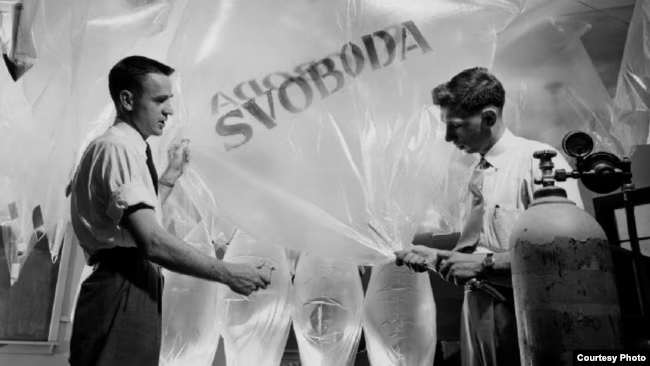Lofty Balloon Campaign Brought RFE Audiences Uncensored Information, Across Frontiers
With its first on-air message on July 4, 1950, Radio Free Europe (RFE) began its mission of providing uncensored news and information to people denied the right of access to a free press.

With its first on-air message on July 4, 1950, Radio Free Europe (RFE) began its mission of providing uncensored news and information to people denied the right of access to a free press. Its first broadcast as “substitute” or “surrogate” media took place during the early years of the Cold War and was addressed to audiences behind the “Iron Curtain” in communist Czechoslovakia. But 70 years on, in a coverage region that has expanded to 26 countries, the essential need for a dependable local news source continues. The balloon campaign of the 1950s exemplified RFE/RL’s (RFE merged with Radio Liberty in 1976) commitment to reach its audiences on every platform, across frontiers.
The campaign, comprising a series of launches often referred to collectively as the “Winds of Freedom,” ran from August 1951 to November 1956 and “sent 590,415 balloons that carried 301,636,883 leaflets, posters, books, and other printed matter from West Germany over the Iron Curtain to Czechoslovakia, Hungary and Poland,” according to Herbert A. Friedman’s detailed study.
The leaflets were meant to augment and promote RFE news coverage. They included a broadcast schedule and short-wave frequencies on one side and, on the other, information about dissident movements and workers’ rights, satirical commentaries on communist leaders and policies, illustrations and cartoons, and messages of support and solidarity from the West. Among the books carried by the balloons were reprints of anti-totalitarian literature, including George Orwell’s Animal Farm.
The balloons were a feat of engineering as well as imagination. Plastic pillow-shaped balloons were produced to take advantage of wind speed and direction and then leak at a predetermined rate before falling with their cargo to a designated city. Round rubber balloons were made to explode in the air and scatter leaflets to a targeted location below. The first balloons were sent to Prague, and were printed on one side with the word Svoboda (freedom) in Czech.
Friedman wrote that “The leaflets were a part of the post-WWII psychological warfare battle between East and West.” In his book Broadcasting Freedom, Arch Puddington recalls the account of a Czech dissident who told him that the leaflets also provided moral support. “I was sitting with three friends in a restaurant. All of a sudden, one of them, a railroad employee, handed me something under the table. I felt some paper in my hand, which I slipped into my pocket. After a while, I went to the restroom and locked myself in. I took the paper out of my pocket…One after the other, friends disappeared into the restroom to read the leaflets…They left deep impressions on our minds. We were enthusiastic and confident that the free world had not forgotten us.”
The governments on the receiving end of the campaigns took notice. After 60,000 balloons were dropped during a campaign known as Operation Prospero, Czech communist authorities deployed anti-aircraft guns and MiG fighter jets to shoot them down. In 1954, West German police stopped a Czech intelligence agent at the border who had orders to burn down one of the launch sites.
RFE historian Prokop Tomek has said the balloon campaign “was an idea that could be used in the 1950s only.” He explained that its strength was in sending over the border pictures and the printed word – “Radio could not do that.” He observed that the pamphlets had the additional value of targeting ordinary people, not elites.
RFE/RL archivist Ross Johnson has pointed out that the leaflets were the precursor to the book campaign, another storied effort that harnessed the power of the printed word to supplement radio broadcasts in closed societies, and carry RFE/RL’s message of hope and freedom.
With thanks to Richard H. Cummings, “Balloons Over East Europe: America’s Covert Radio and Leaflet Operations in the Cold War.” Falling Leaf Magazine: The Quarterly Journal of the PsyWar Society, Issue No. 197, Summer 2008.